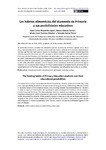Mostrar o rexistro simple do ítem
Los hábitos alimenticios del alumnado de Primaria y sus posibilidades educativas
| dc.contributor.author | Rivadulla-López, Juan-Carlos | |
| dc.contributor.author | García-Barros, Susana | |
| dc.contributor.author | Fuentes-Silveira, María-Jesús | |
| dc.contributor.author | Golías Pérez, Yolanda | |
| dc.date.accessioned | 2020-05-14T11:14:33Z | |
| dc.date.available | 2020-05-14T11:14:33Z | |
| dc.date.issued | 2020 | |
| dc.identifier.citation | Rivadulla López, J. C., García Barros, S., Fuentes Silveira, M., & Golías Pérez, Y. (2019). Los hábitos alimenticios del alumnado de Primaria y sus posibilidades educativas. Ápice. Revista De Educación Científica, 4(1), 63-78. https://doi.org/10.17979/arec.2020.4.1.5236 | es_ES |
| dc.identifier.issn | 2254-7290 | |
| dc.identifier.uri | http://hdl.handle.net/2183/25576 | |
| dc.description.abstract | [Resumen] Se pretende conocer y analizar los alimentos que los alumnos de Primaria ingieren en su día a día y, más concretamente, a la hora de la merienda (media mañana) en la escuela, estableciendo distintos perfiles del alumnado en base a los resultados obtenidos y aportando recomendaciones didácticas para los docentes con el fin de mejorar dichos hábitos. Se trabajó con 967 participantes (510 alumnos de Primaria y 457 familiares del alumnado). La recogida de datos con el alumnado se realizó mediante una investigación diagnóstica (observación directa), mientras que con los familiares se utilizó un cuestionario. Los resultados muestran que la mayoría del alumnado ingiere, en su día a día, alimentos variados y que la mayoría de las meriendas escolares suelen tener alguna carencia. Así, la escuela debe trabajar en mayor profundidad la competencia en alimentación en cooperación con las familias, pues ambos son los agentes más influyentes en la vida de los niños. | es_ES |
| dc.description.abstract | [Abstract] This paper aims to know and analyze the foods that primary school students eat in their day to day and, more specifically, at the time of snack (mid-morning) at school, establishing different profiles of students based on the obtained results and providing didactic recommendations for teachers in order to improve these habits. 967 participants were employed (510 primary school students and 457 students' families). The data collection with the students was carried out by means of a diagnostic investigation (direct observation), while with the relatives a questionnaire was used. The results show that the majority of the students ingests in their day to day varied foods and that the majority of the school snacks usually have some deficiency. the school must work in greater depth the competition in food in cooperation with families, as both are the most influential agents in the lives of children. | es_ES |
| dc.language.iso | spa | es_ES |
| dc.publisher | Universidade da Coruña | es_ES |
| dc.relation.uri | https://doi.org/10.17979/arec.2020.4.1.5236 | es_ES |
| dc.rights | Atribución-Compartir igual 4.0 Internacional (CC BY-SA 4.0) | es_ES |
| dc.rights.uri | https://creativecommons.org/licenses/by-sa/4.0/deed.es | * |
| dc.subject | Educación para la salud | es_ES |
| dc.subject | Educación primaria | es_ES |
| dc.subject | Alimentación | es_ES |
| dc.subject | Meriendas escolares | es_ES |
| dc.subject | Health education | es_ES |
| dc.subject | Primary education | es_ES |
| dc.subject | Feeding | es_ES |
| dc.subject | School snacks | es_ES |
| dc.title | Los hábitos alimenticios del alumnado de Primaria y sus posibilidades educativas | es_ES |
| dc.title.alternative | The Feeding Habits of Primary Education Students and Their Educational Possibilities | es_ES |
| dc.type | info:eu-repo/semantics/article | es_ES |
| dc.rights.access | info:eu-repo/semantics/openAccess | es_ES |
| UDC.journalTitle | Ápice. Revista de Educación Científica | es_ES |
| UDC.volume | 4 | es_ES |
| UDC.issue | 1 | es_ES |
| UDC.startPage | 63 | es_ES |
| UDC.endPage | 78 | es_ES |






